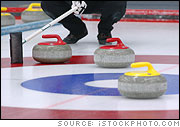2006 Olympics: Curling

Think shuffleboard on ice
by Mike Morrison and Christine Frantz
 Related LinksDid You Know?Curling is one of four winter Olympic sports being contested indoors. The other three are hockey, figure skating, and speed skating. |
The sport of curling dates as far back as the early 1500s in Scotland and was reportedly brought to North America by British troops in the 1700s during the Revolutionary War.
Curling made its Olympic debut at the original Olympic Games in 1924. It came back in the 1932 Lake Placid Games as a demonstration sport, but then went on a 56-year Olympic hiatus, until it returned as a demonstration sport at the 1988 and 1992 Games. Curling was brought back again as an official medal sport at the 1998 Nagano Games.
As far as the actual game goes, think shuffleboard on ice combined with the strategy of a game of bowls or bocce.
Each match is made up of ends, or periods, where two teams of four players each take turns sliding 42-pound polished granite stones down a sheet of ice towards a bullseye made up of four concentric circles. This bullseye, which is 12 ft in diameter, is known as the "house" and its center the "tee." The tee is located 126 ft from where the shooter starts.
When the stone is released by the shooter, it is done with a special technique that involves a twist of the wrist. Like a bowling ball hooks (or curves) down an alley, so too does the stone as it glides down the ice. This curve is known as the "curl."
As the stone curls towards its intended target (perhaps the tee, or perhaps an opponent's stone that happens to be in the way) the other three team members sweep the ice with brooms, causing the stone to speed up or change directions. The "skip" is the captain of the team and usually shouts out sweeping instructions.
Each team member shoots twice, so there are 16 shots in each end. A team scores points when its stones are closest to the tee after all 16 shots. Each match consists of 10 ends.
In 2002, the Norwegian men and Great Britain's women were gold medalists. The Canadian men and Swedish women took the gold at the 2005 World Championship, but the second-place U.S. women gave the Swedes a tough match and look good for medaling at Torino.
After Salt Lake City, curling showed a surge in popularity both in the U.S. and abroad. In the U.S. new clubs formed in places as unlikely as Texas, Arizona, and Tennessee. The U.S. Curling Association membership grew by about 15%. And yes, there is a risqué 2006 calendar: women curlers from seven countries (none from the U.S.) posed in the buff or scantily clad.
- More about the 2006 Winter Olympics
